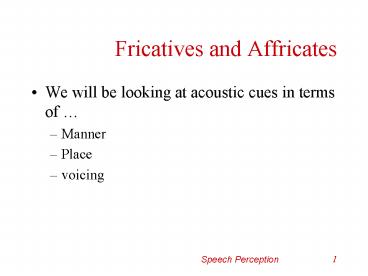Fricatives and Affricates - PowerPoint PPT Presentation
1 / 17
Title:
Fricatives and Affricates
Description:
Fricatives and Affricates We will be looking at acoustic cues in terms of Manner Place voicing Fricatives and Affricates (manner) Manner Different from stops in ... – PowerPoint PPT presentation
Number of Views:1532
Avg rating:3.0/5.0
Title: Fricatives and Affricates
1
Fricatives and Affricates
- We will be looking at acoustic cues in terms of
- Manner
- Place
- voicing
2
Fricatives and Affricates (manner)
- Manner
- Different from stops in that fricatives are
continuants. - Noisy aperiodic component
3
Fricatives and Affricates (place)
- Place
- Absolute intensity of fricative.
- Spectral frequency
4
Fricatives and Affricates (place)
- Center frequencies will change depending upon
vowel context (adaptation) - Other fricatives have more spectral spread and is
difficult to identify by spectral frequency
alone. - F2 transition points roughly to center frequency.
e.g., the F2 transition for /s/ points to about
4000 Hz. These transitions are important for
perception of other fricatives which have weak
center frequencies. - Affricates contain aspects of both stops and
fricatives.
5
Fricatives and Affricates (place)
6
Suprasegmentals
- Suprasegmental perception is poorly understood
when compared to suprasegmental production.
7
Suprasegmentals (intonation)
- Intonation
- Ability to changes in intonation is dependent
upon ability to track pitch. - Physiological mechanisms for decoding are unknown
be probably in Wernikes area.
8
Suprasegmentals (intonation)
9
Suprasegmentals (intonation)
- System analyzes speakers harmonic structure of
speech and then can determine fo and track pitch
and fo changes by analyzing change in harmonics
(e.g., hearing aids and telephones).
10
Suprasegmentals (stress juncture)
- Stress is determined by changes in pitch,
loudness and duration. - Juncture is determined by silent periods, vowel
duration or other features such as voicing or
aspiration. - Physiological mechanisms for loudness and
duration are also thought to be in temporal lobe
of cortex.
11
Context
- Perception of allophones, phonemes, syllables,
words or even phrases are dependent upon context.
(e.g., spin test) - Being able to identify context is important for
speech perception, especially for people with
hearing loss.
12
Categorical Perception
- Refers to ability of a listener to discriminate
on phoneme or perceptual cue from another based
on subtle differences in the acoustic cues. - Categorical boundaries are an important part of
categorical perception. Provide examples. - Study by Liberman (1957) shows how changes in F2
formant frequency can influence perception. They
looked at ability to identify phonemes and to
discriminate between phonemes.
13
Categorical Perception
- Describe study
14
Categorical Perception
- Similar studies have been used to study virtually
every known acoustic cue. - People with cochlear hearing loss interferes with
categorical perception. What are implications?
15
Categorical Perception
- Effects of Language
- Effects of Instinct
- Best guess is both play an important role.
16
Hearing Loss and Speech Perception
- Review Audiogram
- Effect on speech dynamics and specific phonemes
- Effect on suprasegmentals
- Effect on categorical perception
17
Summary































